RiverRoots: Ice Jams on the Susquehanna
River Roots: Ice Jams on the Susquehanna
River Roots is Susquehanna NHA’s blog series featuring history from York and Lancaster Counties that showcases the Susquehanna River’s historic, cultural, and natural resource contributions to our nation’s heritage.
For those who live along the Susquehanna River’s banks, ice is a common winter sight. It has jammed on the Susquehanna since the rocky ridges of our region rose up around the river. Residents harvested ice as a winter crop for use in iceboxes before modern refrigeration. However, when the conditions are right, ice can be terribly destructive on our waterways. Ice jams are responsible for some of the most devastating flooding events on the Lower Susquehanna.
What is an ice Jam?
An ice jam is an obstruction of broken-up ice that clumps together to block the flow of a waterway. There are two types of ice jams: freeze-up, and break-up. Freeze-up ice jams happen in the early to mid winter, when changing water slows or stops floating ice as it reaches an obstruction. Beak-up jams occur during late winter and early spring thaws. They are usually associated with a rapid increase in runoff, because warm temperatures and heavy rain cause snow to rapidly melt. Heavy rainfall or fluctuating temperatures break up the ice cover. Melting snow and ice can swell the river, which breaks the surface layer of ice. Increasing water levels can lift and break ice cover, carrying frozen chunks downstream. As floating ice builds up, it forms thick layers that sometimes reach great heights. Ice jams commonly develop near river bends, mouths of tributaries, and points where the river slope decreases. They also form downstream of dams and upstream of bridges. The accumulation of ice obstructs the flow of water, resulting in increased and unpredictable local flooding.
Ice jams can stay in place for a few minutes or many days. They can stretch a few hundred feet or many miles long. Ice jam floods are less predictable and potentially more destructive than typical open-water flooding. They can produce much deeper and faster flooding that lasts longer.
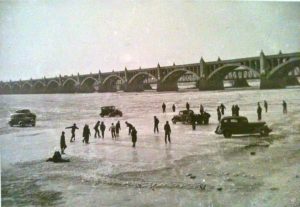
Historic Ice Jams on the Lower Susquehanna
Ice on the Susquehanna River is both interesting and concerning. Although not every ice jam is dangerous, this natural phenomenon can be catastrophic in the Susquehanna River region. The first Euro-American records of an ice jam flood on the Susquehanna date back to 1784. Ice ruined many bridges, canals, railroads, and communities on the Susquehanna (and its tributaries) throughout the 19th and 20th centuries. We’ll touch on just a few of those notable instances in the region.
1832 First Columbia and Wrightsville Bridge Destroyed
During an extremely cold winter in 1832, thick ice hardened on the Susquehanna and stacked to great heights where the river was shallow. Spring thaw came quickly and created the right conditions for ice jam flooding. When the ice began to break up and flow down the river, the water rose 30 feet! It swept homes, barns, and even cattle along the river. Ice jammed up south of Columbia and created a natural dam. Water and ice rose and lifted the first bridge that spanned the Susquehanna off its piers. The flood destroyed the bridge, the longest covered bridge in the world at the time.
1904 Great Ice Flood
The stage was set for natural disaster in 1904, when an especially frigid winter froze the Susquehanna solid. Merchants crossed horse-drawn freight wagons between Lancaster and York counties on the 2ft thick ice. However, when the ice began to break up, it caused the greatest flood ever on the Susquehanna.
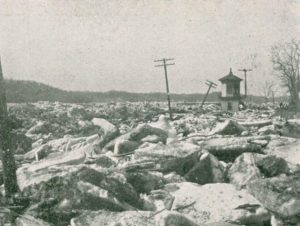
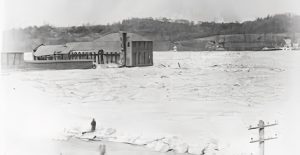
Just as workers were putting the finishing touches on the York Haven Dam (one of the first hydroelectric projects on the Lower Susquehanna River), the ice jammed. Ice and flooding collapsed the superstructure of the building and caused major damage. The floodwaters rushed downriver, carrying blocks of ice with it, that battered the paper mill at York Haven. The ice almost completely destroyed the village of Collins in Conoy Township; after the ice flood, all that remained of the town was a single railroad control tower.
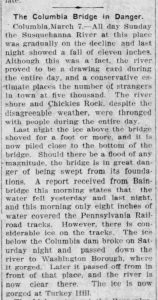
The flowing flood waters and ice met with an ice gorge in Bainbridge and began to flow downriver. The water dislodged the Bainbridge train station and carried it a mile south on the railroad tracks. The river washed away parts of the newly constructed bridge of the Atglen and Susquehanna (A&S) line, taking the Shocks Mill Railroad Bridge with it. Mud and ice coated river towns like Marietta, Columbia, Wrightsville, and Washington Boro as the river pushed the destruction downriver.
Thousands visited Columbia and Wrightsville to view the immense buildup of water and ice. The tower almost reached the steel railroad bridge and everyone feared that the ice would destroy the great structure, especially after part of the new railroad bridge was carried down against it.
The floodwater and ice combined with and dislodged an ice gorge at Turkey Hill, south of Columbia. This formed an enormous ice gorge below Safe Harbor. At Turkey Hill, 30 feet of water covered the railroad tracks, which are 20 feet above the low water mark. The river had risen to about 50 feet deep. Once the river found its way through the blockage, it destroyed a significant section of Safe Harbor village. The violent rush of floodwater only lasted 15 minutes. Together, the ice and floodwaters crushed, mangled, and lifted buildings from their foundations as it submerged part of the town. The flood tore away the stone Pennsylvania Railroad (PRR) bridge that crossed the Conestoga River. In Pequea, the water rose 12ft in 10 minutes and pushed another bridge up Pequea Creek.
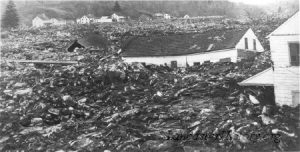
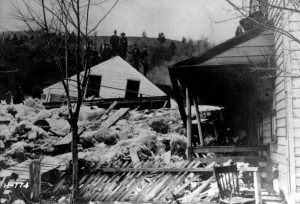
The PRR mainline to Columbia and the Columbia & Port Deposit Railroad (C&PD) were both badly damaged. PRR’s Low-Grade line was in the process of being laid out but had to halt construction. The railroad beds were greatly damaged requiring lengthy repairs. The flood tore away sections and wedged them under huge cakes of ice. For about a week, the tracks were useless, blocked by floods that carried millions of tons of ice downriver. The railroad lines froze; ice was up to 30ft deep in some spots. Wreckage of buildings, masses of rock and earth, trees, and all sorts of debris covered the railroads.
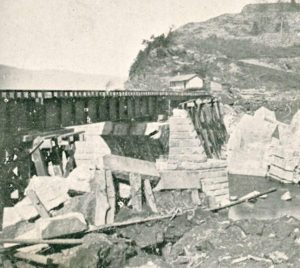
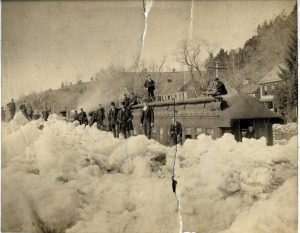
The PRR pulled men off the Low-Grade construction crews to work on opening the line between Columbia and Harrisburg. Equipped with six steam shovels, they attacked the ice that covered the railroads. It took quite a while to resume service on the mainline via Columbia. The standstill congested freight at Harrisburg and forced passenger trains to run lengthy alternative routes.
1920 Interesting Solution
In 1920, the Susquehanna River froze sold for 83-day streak. In early March, a quick thaw caused severe ice jams. They were so severe that an unorthodox solution to prevent the devastating flooding: they decided to drop bombs on the Susquehanna River. Colonel H. W. Scull, who is credited for the idea, received permission to execute the experiment.
The Colonel oversaw several days of aerial bombing, using 250lb TNT bombs to break up the 16-foot-thick-jams. The bombs seemed successful, until the ice jammed up again. The next day, they dropped four 500lb TNT bombs into the ice gorge between Port Deposit and Havre de Grace, successfully allowing the jam to start flowing. Following that success, arrangements were made to bomb the ice-choked sections of Columbia, Safe Harbor, Washington Boro, and Holtwood. It was decided that bombing the river above the Conowingo Dam wasn’t necessary, as weather conditions allowed for a safe thaw.

Today, warmer weather conditions mean less aggressive ice buildup on the Lower Susquehanna River. It’s difficult to imagine the destructive force and sheer heights of the ice responsible for such a destruction.
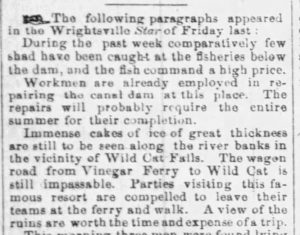
Learn More
Visiting the Susquehanna River during winter provides a unique and memorable experience! Ice building up along the riverbank creates a stunning winter landscape to enjoy. As ice crunches against ice, ominous creaking and groaning sounds fill the air. Thick slabs of ice let out thunderous booming sounds as they expand over the riverbank. It’s no wonder why the people of York and Lancaster counties flooded to the river to see this great spectacle for centuries.
Read the full article about bombing Susquehanna River ice jams in 1920. You will need a subscription to LancasterOnline to access it.
View a recent ice jam flooding event from Fox43’s video of Long Level and Wrightsville in 2018.
Read about the Frankenstorm! in the YorksPast Blog by Stephen H. Smith.
Sources
Crable, Ad. (2018, April 13). The ice flood that swallowed up a Lancaster County town along the Susquehanna [photos]. LancasterOnline.
Brubaker, J. H. (2002). Down the Susquehanna to the Chesapeake. University Park, Pa: Pennsylvania State Univ. Press.
York Inquirer . (1904, March 12). Safe Harbor Almost Wiped Out. Ice freshet.
Kiner, D. (2021, March 17). ‘tremendous damage’: The St. Patrick’s Day Flood of 1936 devastated pa. Pennlive.
Quesenbery , E. (2014, March 19). The day they bombed the Susquehanna. Cecil Daily.
Smith, S. H. (2014, May 31). End of may, over ten-feet of ice at Lockport along Susquehanna in York County; connection to Apollo Moon Mission. York’s Past.
Smith, S. H. (2018, January 21). York’s past: Aerial bombing breaks susquehanna ice jams. York Daily Record.
Stranahan, S. Q. (1995). Susquehanna, river of dreams. Baltimore, MD: Johns Hopkins Univ. Press.

